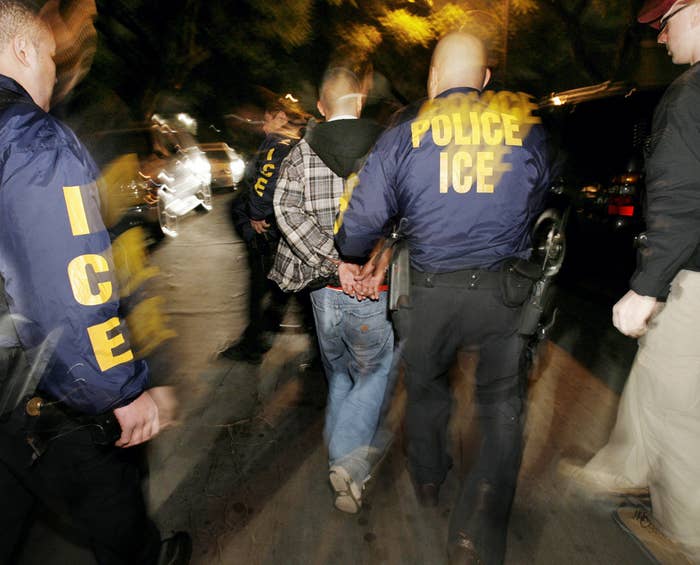
Immigration and Customs Enforcement officials have drawn up guidance to direct officers to focus primarily on certain groups of immigrants, such as those suspected of being a national security threat, and require high-level approval for street operations as part of a draft memo obtained by BuzzFeed News that, if implemented, would likely lead to a significant drop in arrests.
The draft interim guidance was authored by acting ICE Director Tae Johnson and applies to all decisions the agency makes in the US, including detaining or arresting undocumented immigrants. It includes a section on implementing a 100-day deportation moratorium, but that plan was blocked by a federal judge in Texas on Tuesday. The judge’s order, however, did not stop the Biden administration from moving forward with changing ICE’s arrest priorities.
“This guidance will significantly pare back ICE operations. By imposing reporting requirements for any arrests occurring outside of the administration's narrow priorities and for any arrests occurring at-large or in communities, they are all but guaranteeing that immigration enforcement will be concentrated on a small number of individuals in criminal custody,” said Sarah Pierce, an analyst at the Migration Policy Institute. “The Biden administration is quickly eliminating any Trump changes designed to keep unauthorized immigrants ‘looking over their shoulders.’”
ICE officials did not immediately respond to a request for comment.
The draft directive is one step of the new administration’s attempts to reform the way ICE uses its resources and was requested by David Pekoske, acting Homeland Security secretary, on Jan. 20.
In the guidance, which would take effect on Feb. 1, ICE officials recognize that their resources are limited, an argument that many advocates and former agency leaders have made.
“The total number of noncitizens estimated to be unlawfully present in the United States is in the millions. Meanwhile, ICE’s resources allow for the removal of a few hundred thousand noncitizens annually...It is neither possible nor practical to prioritize every noncitizen who is unlawfully present in the United States,” the memo states. “Therefore, ICE must prioritize its resources to undertake more effective and efficient immigration enforcement in order to manage an already overburdened caseload.”
Former president Donald Trump’s directive in 2017 made nearly every undocumented immigrant a priority for arrest. Not long after, ICE prosecutors were restricted from granting reprieves for certain immigrants facing deportation and ordered to review and potentially reopen previously closed cases, which was first revealed by BuzzFeed News through Freedom of Information Act requests. Soon, the proportion of immigrants with no prior criminal convictions who were being arrested and placed into deportation proceedings shot up.
The groups of people ICE officers would focus on include those suspected of being a national security threat, recent border crossers, and those who have been released from jail after being convicted of an aggravated felony. The draft guidance includes an additional priority for those deemed to otherwise pose “a threat to public safety.”
Officers would be told that the vague phrase should be considered to include all “relevant facts,” like extensiveness, seriousness, and recency of the criminal activity, as well as any mitigating factors like rehabilitation.
“When the totality of the circumstances are considered, the key question in deciding whether the noncitizen poses a threat to public safety is whether the noncitizen’s continued presence presents a significant, articulable danger to the persons of the United States,” the draft memo states.
The draft directive requires that the decision to arrest anyone outside of the three priority groups must be made “in writing” by the local office director and include why the individual is being pursued, that the action serves the “federal interest,” and that it would not displace resources against others who are higher priorities. If there aren’t emergency circumstances, the write-up must be recorded before the arrest and reported to senior leaders in Washington, DC.
Elsewhere, ICE officials who want to conduct any arrest outside of federal, state, or local prisons or jails must have approval from the agency’s leader, Johnson, before moving forward.
The approval must also be received before the arrest, unless there are exigent circumstances.
The draft also requires that ICE begin recording and measuring their effectiveness with complying with the memorandum on a regular basis starting after Feb. 14. Meanwhile, an internal review regarding the deployment of officers, policies surrounding prosecutorial discretion, and interaction with state and local law enforcement has started.
The draft directive, if kept untouched, will be in place as the Biden administration conducts its planned review of ICE protocols, after which new priorities are expected to be issued.
